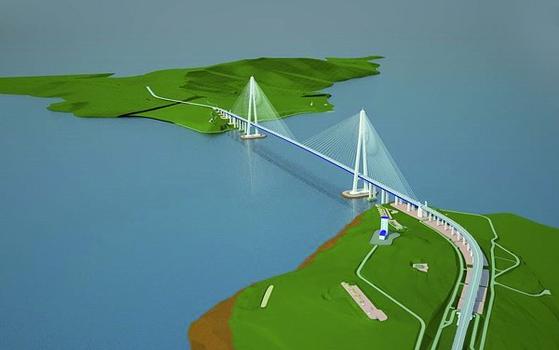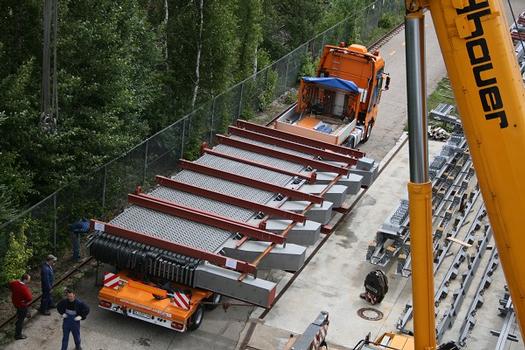Comprehensive Structural Protection at the World’s longest Cable Stayed Bridge
In 2012, on Russki Island near Wladiwostok the APEC Summit will take place. In the past the Island was off-limits, now a conference centre emerges as well as a new town. The new road bridge with two lanes per direction connects the island with Wladiwostok and has a length of 1,872 m. Together with the approach bridges the total length encompasses 3 km. The Russki Bridge will have a main span of 1104 m and two pylons of a height of 312 m.
A particularity of this huge bridge is the mode of construction: for structural reasons, the shorter bridge decks towards the land are made of concrete, and the longer bridge deck between the pylons is made of "light" steel.
Dampers for the 65-Ton-Cables
Of all elements of structural protection, the cable dampers pose the biggest challenge. The world's longest stay cables will employ a length of 578 m and a dead weight of 65 tons, plus eventual ice that in wind shade may freeze to the cables. At this bay, extreme weather conditions have to be dealt with, like storms, rain pours and fast changing weather conditions in a temperature range of -50°C to +40°C. These factors may trigger a variety of different vibrations of this relatively soft and elastic bridge deck.
Depending on their length, the stay cables are damped in different ways among others with 184 passive and 40 adaptive hydraulic dampers. The longest 20 cables with a length exceeding 483 m will be equipped with adaptive dampers. Core of these adaptive dampers is an electronic system which measures the actual vibrations of the stay cables and from there calculates the optimum damping forces. For this damping system, Maurer Söhne cooperates with the renowned French Cable Manufacturer Freyssinet and the Swiss EMPA located in Dubendorf.
Bridge Deck Dampers for Wind and Earthquake
At each end, the Russki Bridge will be equipped with 3 hydraulic dampers with each 300 tons response force, which are designed to reduce the pendulum movements of the bridge to tolerable levels. These hydraulic dampers display a movement capacity of 2.2 m and are 6.5 m long. Their job is to buffer up to 7 million wind load cycles and to limit the seismic movements of the bridge deck to +/- 350 mm. The bridge is located in a zone of seismic activity of Richter scale 8.1.
In September 2011, tests are planned at the University of California in San Diego/U.S.A.. Only there, test equipment is available for the testing of such large dampers.
Very large Expansion Joints with Anti-Skid-Protection
Of a length of 23.5 m, the expansion joints of type XLS2400 not only will accommodate the standard longitudinal movements of the bridge, but can also perform up to 2,400 mm of movement in case of an earthquake without being damaged. In addition, the expansion joints are equipped with diamond shaped elements which ensure protection from skidding. Such diamond shaped elements usually are employed to protect against noise emission of the expansion joints. Therewith, these expansion joints are the world's greatest with integrated noise protection.
The biggest Bridge Bearings of their kind which were ever manufactured
In total, the Russki Bridge will employ 24 guided sliding bridge bearings: each 2 at the two pylons, at the two abutments and on the 4 piers between pylon and abutment. The load range is from 1,200 t up to 3,400 t.
The horizontal force bearings at the pylons employ a weight of 40 tons, being 5 m long, 3 m wide and 80 cm high. This makes them the largest bearings which were ever manufactured for such a bridge. These bearings are guided and facilitate a longitudinal movement, caused by temperature, wind, and earthquake, of ± 1,2 m. In longitudinal direction the bearings will have to transfer 2,500 t, in lateral direction 2,000 t. This corresponds to a weight of about 60 fully loaded trucks.
Changing fixations in construction mode
A particularity during construction is the fact that the horizontal movement will be blocked by way of bolted fixation elements. This way, during construction the bridge deck is being stabilized against storms and earthquake. Only when the last bridge segment is placed in the centre of the bridge, these fixations will be removed.
References
Structure Types
- About this
data sheet - Product-ID
5996 - Published on:
14/08/2012 - Last updated on:
19/05/2017



 MAURER SE
MAURER SE 


